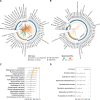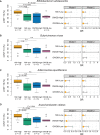Gut microbiota composition is associated with SARS-CoV-2 vaccine immunogenicity and adverse events
- PMID: 35140064
- PMCID: PMC8844967
- DOI: 10.1136/gutjnl-2021-326563
Gut microbiota composition is associated with SARS-CoV-2 vaccine immunogenicity and adverse events
Abstract
Objective: The gut microbiota plays a key role in modulating host immune response. We conducted a prospective, observational study to examine gut microbiota composition in association with immune responses and adverse events in adults who have received the inactivated vaccine (CoronaVac; Sinovac) or the mRNA vaccine (BNT162b2; BioNTech; Comirnaty).
Design: We performed shotgun metagenomic sequencing in stool samples of 138 COVID-19 vaccinees (37 CoronaVac and 101 BNT162b2 vaccinees) collected at baseline and 1 month after second dose of vaccination. Immune markers were measured by SARS-CoV-2 surrogate virus neutralisation test and spike receptor-binding domain IgG ELISA.
Results: We found a significantly lower immune response in recipients of CoronaVac than BNT162b2 vaccines (p<0.05). Bifidobacterium adolescentis was persistently higher in subjects with high neutralising antibodies to CoronaVac vaccine (p=0.023) and their baseline gut microbiome was enriched in pathways related to carbohydrate metabolism (linear discriminant analysis (LDA) scores >2 and p<0.05). Neutralising antibodies in BNT162b2 vaccinees showed a positive correlation with the total abundance of bacteria with flagella and fimbriae including Roseburia faecis (p=0.028). The abundance of Prevotella copri and two Megamonas species were enriched in individuals with fewer adverse events following either of the vaccines indicating that these bacteria may play an anti-inflammatory role in host immune response (LDA scores>3 and p<0.05).
Conclusion: Our study has identified specific gut microbiota markers in association with improved immune response and reduced adverse events following COVID-19 vaccines. Microbiota-targeted interventions have the potential to complement effectiveness of COVID-19 vaccines.
Keywords: COVID-19; enteric bacterial microflora; immune response.
© Author(s) (or their employer(s)) 2022. Re-use permitted under CC BY-NC. No commercial re-use. See rights and permissions. Published by BMJ.
Conflict of interest statement
Competing interests: The Chinese University of Hong Kong and The University of Hong Kong have filed a provisional patent application in connection with this work on which SCN, FKLC and HMT are inventors (US patent application no. 63/273,088). FKLC and SCN are the scientific co-founders and sit in the board of Directors of GenieBiome Ltd.
Figures




Comment in
-
Dynamic changes in host immune system and gut microbiota are associated with the production of SARS-CoV-2 antibodies.Gut. 2023 Oct;72(10):1996-1999. doi: 10.1136/gutjnl-2022-327561. Epub 2022 Oct 7. Gut. 2023. PMID: 36207022 Free PMC article. No abstract available.
-
Gut microbiome and dietary fibre intake strongly associate with IgG function and maturation following SARS-CoV-2 mRNA vaccination.Gut. 2023 Dec 7;73(1):208-210. doi: 10.1136/gutjnl-2022-328556. Gut. 2023. PMID: 36549875 Free PMC article. No abstract available.
-
Exploring the impact of gut microbial metabolites on inactivated SARS-CoV-2 vaccine efficacy during pregnancy and mother-to-infant antibody transfer.Gut. 2024 Jul 11;73(8):1397-1400. doi: 10.1136/gutjnl-2023-330497. Gut. 2024. PMID: 37739779 Free PMC article. No abstract available.
References
-
- World Health Organization. Available: https://www.who.int/emergencies/diseases/novel-coronavirus-2019 [Accessed 17 Jan 2022].
-
- Haas EJ, Angulo FJ, McLaughlin JM, et al. Impact and effectiveness of mRNA BNT162b2 vaccine against SARS-CoV-2 infections and COVID-19 cases, hospitalisations, and deaths following a nationwide vaccination campaign in Israel: an observational study using national surveillance data. Lancet 2021;397:1819–29. 10.1016/S0140-6736(21)00947-8 - DOI - PMC - PubMed
Publication types
MeSH terms
Substances
LinkOut - more resources
Full Text Sources
Other Literature Sources
Medical
Miscellaneous
